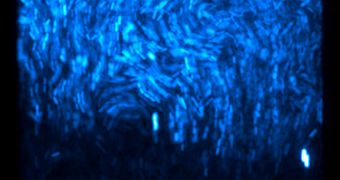University of California in San Diego (UCSD) investigators announce the creation of a living neon sign that is powered up by millions of bacterial cells. Fluorescent proteins attached to the cells' biological clocks allow them to blink in unison, just like LED or light bulbs would in a street ad billboard.
The instrument was developed by a collaboration of biologists and bioengineers at the university. Details of their work appear in the latest advanced online issue of the top scientific journal Nature.
Once the concept behind the instrument was established, constructing it was a rather simple job. The team first had to attach fluorescent proteins to the bacterial cells' biological clocks, and then synchronize all bacteria in a colony to emit light at the same time.
They then synchronized thousands of colonies to glow and dim in unison. The achievement marks an important milestone in the relatively new field of synthetic biology, which seeks to enable scientists to create living, machine-like cells, which can then be used for practical applications.
In an offshoot of the current research, the team was able to produce a smaller array of bacterial colonies that is capable of glowing when it detects minute traces of arsenic in its environment. Conceivably, the sensor could be taught to identify other dangerous compounds as well.
Having access to low-cost bacterial biosensors would make it easier for people living in developing countries and the Third World to assess the quality of drinking water. This is still one of the worst problems in the world, and the situation now shows no signs of improvement.
One of the advantages this type of biosensors would have over every other in existence today – other than a low cost – is that they can monitor whatever chemical they were built to identify over prolonged periods of time.
“These kinds of living sensors are intriguing as they can serve to continuously monitor a given sample over long periods of time, whereas most detection kits are used for a one-time measurement,” explains UCSD professor of biology and bioengineering Jeff Hasty.
“Because the bacteria respond in different ways to different concentrations by varying the frequency of their blinking pattern, they can provide a continual update on how dangerous a toxin or pathogen is at any one time,” he goes on to say.
Hasty was the leader of the research team, which included experts from the UCSD Division of Biological Sciences and the BioCircuits Institute.

 14 DAY TRIAL //
14 DAY TRIAL //